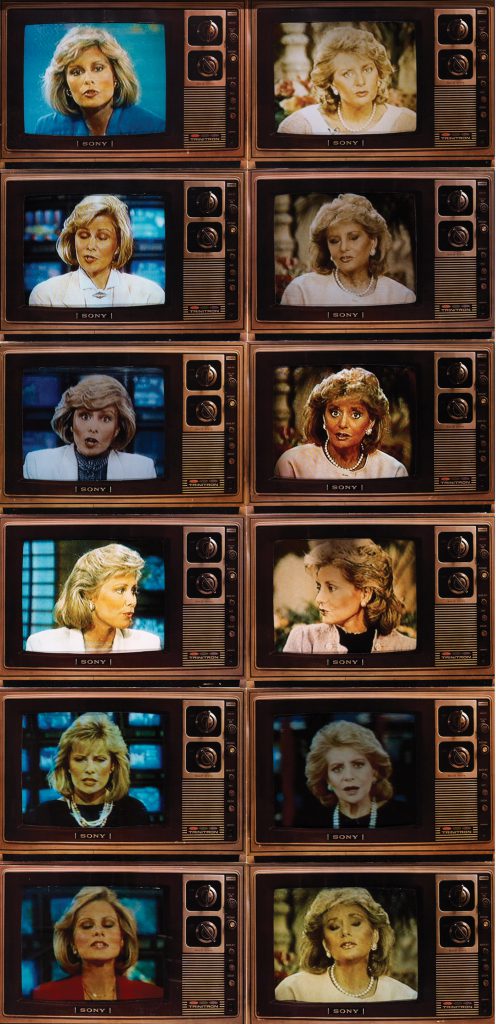With Breaking News: Turning the Lens on Mass Media, the Getty Center offers an insightful, incisive, intellectually rigorous engagement with the visual side of the Fourth Estate. The exhibition presents the works of 17 artists realized in the course of the last four decades in a meta-critique on how geopolitical events are packaged and presented for mass consumption. The news is not only the subject, but the literal raw material of these works. In order to create such effective critiques, these artists appropriate, deconstruct and reassemble specific physical elements of the mechanisms by which information is delivered, exposing the strategies behind the agenda-driven design of the news itself.
Donald Blumberg photographed broadcasts of war news in 1968-69 to constitute his series of Television Political Mosaics. He lavished surrealist post-production on the images; his obvious manipulations pointed up the visual distortions inherent to the original. Works by Ron Jude, Sarah Charlesworth, and especially the wry, casual 14-minute John Baldessari video “The Meaning of Various News Photos to Ed Henderson” (1973) all deal explicitly with the ways an audience’s understanding of an image widely differs, with or without contextualizing information. Omer Fast’s “CNN Concatenated” (2002) constructs a patchwork speech from single words, spoken by dozens of newscasters, strung together to make a new narrative. Through such engaging artifice, Fast exposes the manipulation of ordinary stories and mocks the faux-frantic pace of the 24-hour news cycle. Antoni Muntadas’ “Cross-Cultural Television” (1987) is a dissonant and hypnotic 35-minute alt-broadcast, an all-graphics video bricolage of multilingual intros, voiceovers, music, news crawls, station breaks and off-air screen-test color-bar placards.
Right now there is an entire generation that never knew anything that didn’t come out of this tube. This tube is the most awesome goddamn propaganda force in the whole godless world, and woe is us if it ever falls into the hands of the wrong people.”
—Howard Beale in “Network” (1976)
Catherine Opie’s only Polaroid series, Close to Home (2004-05), concentrated on the TV set in her living room. Robert Heinecken’s TV Newswomen (Faith Daniels and Barbara Walters) (1986) concerns the mediation of information, the illusion of intimacy offered by the TV “in the living room” and the role of gender — the latter having a resonance that has only increased since these images were made. Heinecken termed his photographic process “videograms,” making them by directly contact-printing off the set and appropriating its contents (and its light source) as both message/subject and technical process. Alfredo Jaar also uses appropriation, citing the media itself for evidence of its own failings. In Untitled (Newsweek) (1994) he photographed every cover of the news magazine from the beginning of the Rwandan genocide until 17 weeks later — when Newsweek finally covered it. His captions contained war data, while the images contained none. Searching for Africa in LIFE (1996) contains in a single panel every one of the 2,128 LIFE magazine covers from 1936 to 1996. Five of these covers featured African subjects, all of these either animals or starving villagers. Otherwise entirely unmodified, Jaar’s content speaks for itself with just the simplest shift of context.
Perhaps the most powerful and modern works in the exhibition are Martha Rosler’s photo-based collages comprising the House Beautiful: Bringing the War Home (1967/2011) series. Like Opie and Heinecken, these works partly address the false intimacy of the beamed-in news anchor, as well as the role of gender in the algorithms of trust and truthiness. These were contemporaneous collages about the hypocritical horrors of Vietnam, initially distributed as Xeroxes at anti-war demonstrations. Here as elsewhere, collage is not only an aesthetic strategy but contains its message in its own process. That is, the technique is germane to the meaning, itself being a matter of direct engagement. Rosler’s photomontages juxtapose luxury with suffering, making visible the problematic nature of the so-called “living room war,” in the spirit of Opie, Blumberg and Heinecken, and using the contents of the magazines as evidence against them, as did Jaar. Rosler revisited the series six years ago, and made new photographic prints, as they seemed, like so much in this gem of a show, more relevant than ever in the prevailing political climate.










